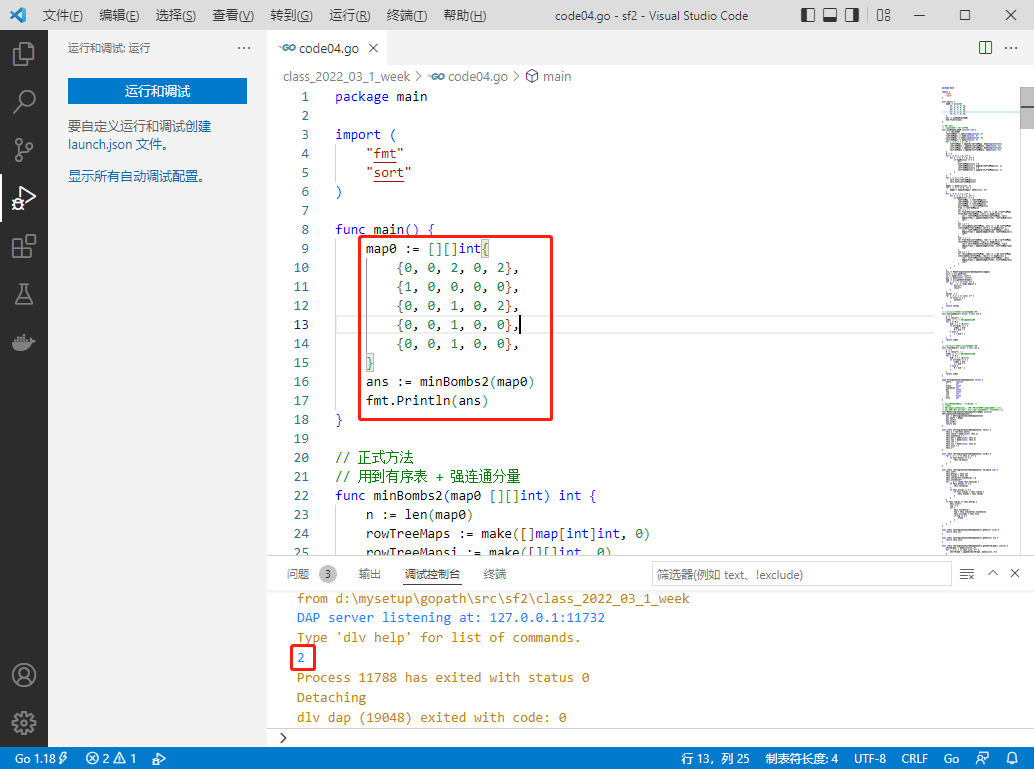2022-05-17:在一个地图上有若干个炸弹,每个炸弹会呈现十字型引爆。 每个炸弹都有其当量值,这个值决定了这个炸弹的爆炸半径。 如果一个炸弹被引爆时,有其它炸弹在其爆炸半径内,那么其它炸弹也会爆炸。 请问使地图上所有炸弹爆炸所需的最少人为引爆次数。 例如: 0,0,0,0,0 0,0,0,1,0 0,0,0,0,0 上图中val为1的单元是一个炸弹,人为引爆后地图变成下面的样子: 0, 0, 0,-1, 0 0, 0,-1,-1,-1 0, 0, 0,-1, 0 题目并没有给数据量,面经题目的通病。 来自亚马逊。
答案2022-05-17:
并查集不对。 贪心最大当量不对。 贪心最多不对。 有序表 + 强连通分量。
代码用golang编写。代码如下:
package main
import (
"fmt"
"sort"
)
func main() {
map0 := [][]int{
{0, 0, 2, 0, 2},
{1, 0, 0, 0, 0},
{0, 0, 1, 0, 2},
{0, 0, 1, 0, 0},
{0, 0, 1, 0, 0},
}
ans := minBombs2(map0)
fmt.Println(ans)
}
// 正式方法
// 用到有序表 + 强连通分量
func minBombs2(map0 [][]int) int {
n := len(map0)
rowTreeMaps := make([]map[int]int, 0)
rowTreeMapsi := make([][]int, 0)
colTreeMaps := make([]map[int]int, 0)
colTreeMapsi := make([][]int, 0)
for i := 0; i < n; i++ {
rowTreeMaps = append(rowTreeMaps, make(map[int]int))
rowTreeMapsi = append(rowTreeMapsi, make([]int, 0))
colTreeMaps = append(colTreeMaps, make(map[int]int))
colTreeMapsi = append(colTreeMapsi, make([]int, 0))
}
m := 0
for i := 0; i < n; i++ {
for j := 0; j < n; j++ {
if map0[i][j] != 0 {
m++
rowTreeMaps[i][j] = m
rowTreeMapsi[i] = append(rowTreeMapsi[i], j)
colTreeMaps[j][i] = m
colTreeMapsi[j] = append(colTreeMapsi[j], i)
}
}
}
for i := 0; i < n; i++ {
sort.Ints(rowTreeMapsi[i])
sort.Ints(colTreeMapsi[i])
}
edges := make([][]int, 0)
for i := 0; i <= m; i++ {
edges = append(edges, make([]int, 0))
}
for i := 0; i < n; i++ {
for j := 0; j < n; j++ {
if map0[i][j] != 0 {
rowTreeMap := rowTreeMaps[i]
rowTreeMapi := rowTreeMapsi[i]
colTreeMap := colTreeMaps[j]
colTreeMapi := colTreeMapsi[j]
from := rowTreeMap[j]
col := j - 1
for floorKey(rowTreeMapi, col) != -1 && j-rowTreeMapi[floorKey(rowTreeMapi, col)] <= map0[i][j] {
col = rowTreeMapi[floorKey(rowTreeMapi, col)]
edges[from] = append(edges[from], rowTreeMap[col])
col--
}
col = j + 1
for ceilingKey(rowTreeMapi, col) != -1 && rowTreeMapi[ceilingKey(rowTreeMapi, col)]-j <= map0[i][j] {
col = rowTreeMapi[ceilingKey(rowTreeMapi, col)]
edges[from] = append(edges[from], rowTreeMap[col])
col++
}
row := i - 1
for floorKey(colTreeMapi, row) != -1 && i-colTreeMapi[floorKey(colTreeMapi, row)] <= map0[i][j] {
row = colTreeMapi[floorKey(colTreeMapi, row)]
edges[from] = append(edges[from], colTreeMap[row])
row--
}
row = i + 1
for ceilingKey(colTreeMapi, row) != -1 && colTreeMapi[ceilingKey(colTreeMapi, row)]-i <= map0[i][j] {
row = colTreeMapi[ceilingKey(colTreeMapi, row)]
edges[from] = append(edges[from], colTreeMap[row])
row++
}
}
}
}
scc := NewStronglyConnectedComponents(edges)
sccn := scc.getSccn()
in := make([]int, sccn+1)
out := make([]int, sccn+1)
dag := scc.getShortGraph()
for i := 1; i <= sccn; i++ {
for _, j := range dag[i] {
out[i]++
in[j]++
}
}
zeroIn := 0
for i := 1; i <= sccn; i++ {
if in[i] == 0 {
zeroIn++
}
}
return zeroIn
}
// 在arr上,找满足>=value的最左位置
func ceilingKey(arr []int, v int) int {
L := 0
R := len(arr) - 1
index := -1 // 记录最左的对号
for L <= R {
mid := L + (R-L)>>1
if arr[mid] >= v {
index = mid
R = mid - 1
} else {
L = mid + 1
}
}
return index
}
// 在arr上,找满足<=value的最右位置
func floorKey(arr []int, v int) int {
L := 0
R := len(arr) - 1
index := -1 // 记录最右的对号
for L <= R {
mid := L + (R-L)>>1
if arr[mid] <= v {
index = mid
L = mid + 1
} else {
R = mid - 1
}
}
return index
}
type StronglyConnectedComponents struct {
nexts [][]int
n int
stack []int
stackSize int
dfn []int
low []int
cnt int
scc []int
sccn int
}
// 请保证点的编号从1开始,不从0开始
// 注意:
// 如果edges里有0、1、2...n这些点,那么容器edges的大小为n+1
// 但是0点是弃而不用的,所以1..n才是有效的点,所以有效大小是n
func NewStronglyConnectedComponents(edges [][]int) *StronglyConnectedComponents {
ans := &StronglyConnectedComponents{}
ans.nexts = edges
ans.init()
ans.scc0()
return ans
}
func (this *StronglyConnectedComponents) init() {
this.n = len(this.nexts)
this.stack = make([]int, this.n)
this.stackSize = 0
this.dfn = make([]int, this.n)
this.low = make([]int, this.n)
this.cnt = 0
this.scc = make([]int, this.n)
this.sccn = 0
this.n--
}
func (this *StronglyConnectedComponents) scc0() {
for i := 1; i <= this.n; i++ {
if this.dfn[i] == 0 {
this.tarjan(i)
}
}
}
func (this *StronglyConnectedComponents) tarjan(p int) {
this.cnt++
this.dfn[p] = this.cnt
this.low[p] = this.cnt
this.stack[this.stackSize] = p
this.stackSize++
for _, q := range this.nexts[p] {
if this.dfn[q] == 0 {
this.tarjan(q)
}
if this.scc[q] == 0 {
if this.low[p] > this.low[q] {
this.low[p] = this.low[q]
}
}
}
if this.low[p] == this.dfn[p] {
this.sccn++
top := 0
for {
this.stackSize--
top = this.stack[this.stackSize]
this.scc[top] = this.sccn
if top == p {
break
}
}
}
}
func (this *StronglyConnectedComponents) getScc() []int {
return this.scc
}
func (this *StronglyConnectedComponents) getSccn() int {
return this.sccn
}
func (this *StronglyConnectedComponents) getShortGraph() [][]int {
shortGraph := make([][]int, 0)
for i := 0; i <= this.sccn; i++ {
shortGraph = append(shortGraph, make([]int, 0))
}
for u := 1; u <= this.n; u++ {
for _, v := range this.nexts[u] {
if this.scc[u] != this.scc[v] {
shortGraph[this.scc[u]] = append(shortGraph[this.scc[u]], this.scc[v])
}
}
}
return shortGraph
}
执行结果如下:







 京公网安备 11010502036488号
京公网安备 11010502036488号